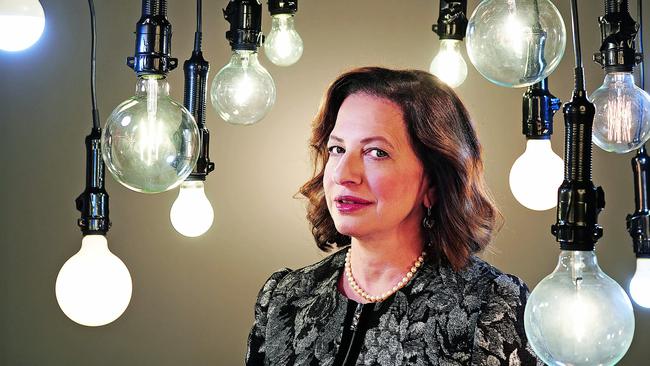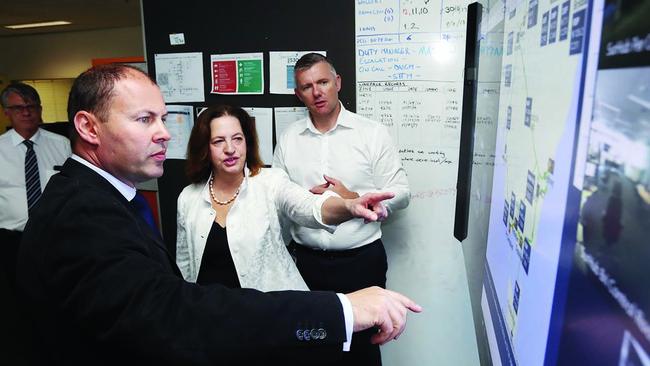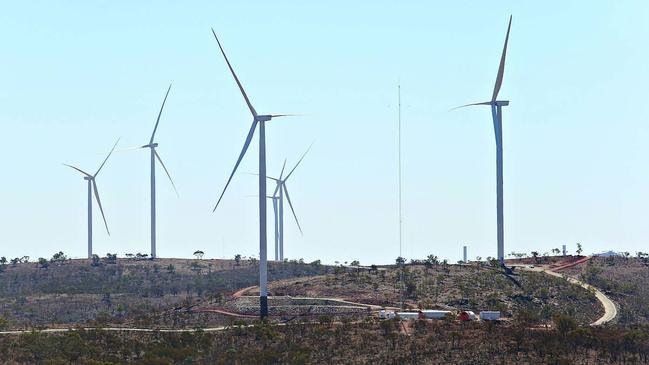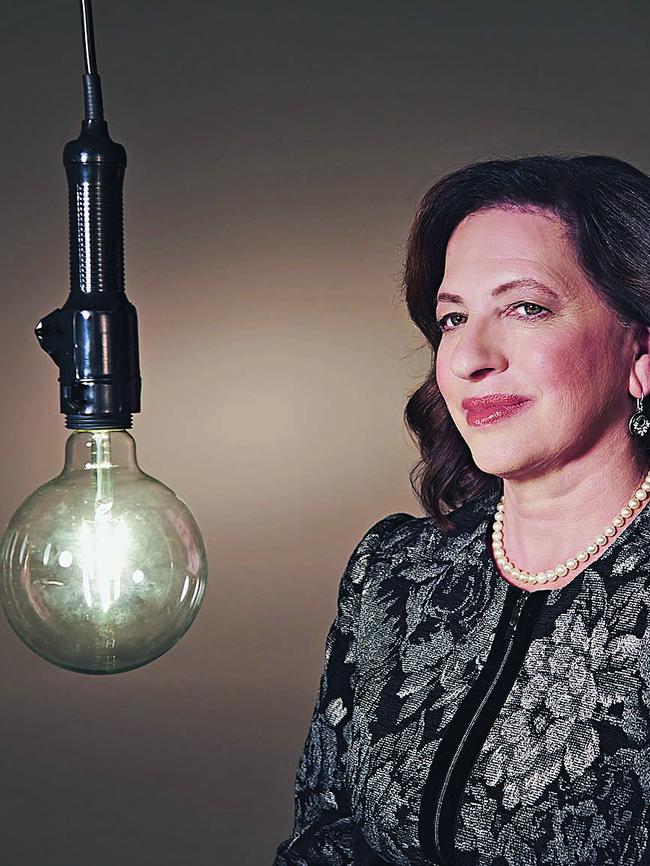Can Audrey Zibelman fix Australia’s energy paralysis?
She’s a seasoned fixer, an American with no patience for political paralysis. Can Audrey Zibelman solve our power woes?

Hi. I’m Audrey,” smiles Australia’s energy czarina Audrey Zibelman, for the zillionth time. She’s been meeting, greeting and listening since she flew here from New York in March 2017 to keep our lights on and our devices charged as we fumble through the biggest disruption the energy industry has faced in a century. Her predecessor at the helm of the Australian Energy Market Operator died suddenly in the job. Two months later a wild storm plunged South Australia into darkness. Now Malcolm Turnbull, whose plan for integrating climate change and energy policy lured her here, has been toppled. The National Energy Guarantee she’d helped craft seems destined to become another acronym in the dumpster of a decade’s fiddling. Summer shimmers menacingly near. Unseasonal bushfires in Victoria and NSW prick alarm while the drought presents a further worry given water’s role in hydro generation and cooling thermal plants. Thank goodness this pocket rocket twice-married grandmother cheerfully admits she works at one setting — high voltage. Patience, she tells me, is not one of her virtues. She wants to get cracking.
There’s a resemblance to Bette Midler beyond her Jewishness, with her auburn bob, pencil skirt and serious heels, and I’d punt she’s got a wild streak based on a glimpse when my tape is turned off. But she’s the A to Z of power. Though she once dreamt of writing poetry in Paris she fell in love with operational systems. She talks megawatts, system inertia, peak load, the alphabet soup of RERT, REZ, USE — this arcane lexicon goes on forever, and she rarely trips. For 30-plus years she’s served huge utility companies and she’s also regulated them. She founded an energy software start-up selling “smart grid” technology and most recently designed a future-proof energy plan for New York following Superstorm Sandy, when Manhattan sloshed under water without power. She was rumoured to be on a shortlist for US Energy Secretary had Hillary Clinton won the White House, but Australia came knocking.
From her office on the 22nd floor of AEMO’s Melbourne headquarters she looks across a skyline of cranes on this overcast winter’s afternoon. The absence of sun or wind is now top of mind since weather and energy are more inextricably bound than ever. She’s fresh from an hour with the nation’s chief meteorologist, grilling him on forecasts for summer. “This past year we’ve had some of the hottest days ever reported in Los Angeles, the hottest days ever reported in Africa, heat in Japan, Norway, fires in Greece,” she tells me. “When it’s that hot it’s not just an issue of inconvenience… you’re talking about public safety. You have to be thinking as it gets hotter to 40 degrees, 45 degrees, what kind of system are we going to need? I take that very seriously.”

Australia’s discordant paralysis over energy was clear from the get-go. The day she touched down in Australia, then SA premier Jay Weatherill shirt-fronted then energy minister Josh Frydenberg in public, accusing him of “white-knuckled panic” over the country’s “broken energy market”. She watched them trade insults on TV as she waited for her suitcases by the carousel. “You warned me it would be difficult but I had no idea it would be like this,” she confided to a colleague as Canberra imploded late last month.
But she will not be distracted. AEMO’s latest electricity forecasts warn that Victoria faces a one in three chance of blackouts during extreme heatwaves this summer. She’s thinking this year, next year, five years, 20 years, juggling an ageing fleet of coal plants, population growth, electrification of transport, technological advances that don’t yet exist. Her miraculous recovery from a terrible car crash in 2013 honed her capacity to concentrate on the next breath, the next hour, the next day, the next hurdle, without losing sight of the horizon.
Weeks before insurgents blew up Turnbull the then energy minister, Josh Frydenberg, allowed a rare moment of candour after a stint campaigning in the Queensland seat of Longman. “It’s killing me,” he sighed, plugging straight back into the Sisyphean task of securing support around an emissions target as he strode into Brisbane airport for the flight home to Melbourne. Singing out to staff — “Which airline are we on?” — he placed his phone in the tray for security then picked up where he left off. “I’ve had to constantly hold my side together,” he fretted. “That’s why no one’s solved this issue for a decade and a half. There can be an obstacle around every corner.” The Coalition’s punishing defeat in Longman and four other by-elections emboldened a handful of coal enthusiasts to mount their coup after exit polls identified household power bills as an electoral migraine. Turnbull threw sticks and carrots to rein them in but appeasement backfired spectacularly.
A lot of people would love to shoot Zibelman down, says Grattan Institute energy analyst Tony Wood. Sydney radio broadcaster Alan Jones tried; he called her “a lefty, a global warming hoax alarmist… that woman — watch her — she should be run out of town”.
Zibelman’s Twitter feed squirms at Donald Trump but she’s foremost a pragmatist dedicated to delivering reliable, resilient and affordable power to consumers. “My personal feelings and politics have nothing to do with the job I’ve been asked to do,” she says. “The economy is totally dependent on getting this right. It has a huge public purpose and that’s why I get frustrated when people try to make political hay out of it because it is too important.”
As smoke cleared from bushfires in Victoria and coastal NSW and the Morrison Government rose from the Coalition’s ashes, Zibelman flew to an international energy conference spruiking her plan for Australia’s orderly transition to the new world order. The National Energy Guarantee she’d hammered out with a posse of mostly female regulators smoulders but the growth of new renewable plant and storage technology has an unstoppable momentum. Her Integrated System Plan or ISP plots a course for the next 20 years. It promises an interconnected energy highway that will increase transfer capacity between the states and connect a portfolio of energy sources through new transmission lines to shore up the nation’s grid.

Coal remains the heavy lifter, delivering 60 per cent of generation by 2030, when renewables will have grown to an estimated 36 per cent. There were 14,064 small solar units on Australian rooftops in 2008; AEMO counted 1.6 million last year. Victoria’s promise to bankroll renewables on the eve of an election will rev up the rollout. Zibelman wants to sweat our ageing coal plants for as long as possible because there is no sign investors are prepared to build a new one. We desperately need new utility-scale generation to smooth the inevitable transition towards a diverse mix of alternative sources, namely pumped hydro, flexible gas-powered generation, distributed energy resources (in which consumers feed energy back into the grid) and innovative demand responses.
Japan turned to the demand side after the tsunami damage to the Fukushima nuclear plant with companies and households rewarded for reducing their energy use to get through peak strain. Who would have dreamt that switching air conditioners off across the country for 15-minute cycles would be the equivalent of turning on a power plant? “Think of the embedded resources we can use,” Zibelman urges.
AEMO is piloting 10 projects that engage consumers big and small in remotely switching on and off appliances or shifting production schedules to help manage spikes during peak demand. When she started in this industry 30 years ago the most exciting breakthrough was increased efficiency of gas generators. Now, the rate of advances makes her giddy.
The chance to blaze a trail drew Zibelman to ourshores. “The reason I came here was that this shift towards renewables is happening here faster than anywhere else. We’re an island. We have to fix it and other jurisdictions are going to need our model.” Paula Conboy, the Canadian-born head of the Australian Energy Regulator, the agency in charge of monitoring market conduct, also jumped at this once-in-a-lifetime opportunity. “We’re at the leading edge here,” Conboy told me before the national policy crumbled.
Both of them sit on the Energy Security Board, which was established by the Finkel Review to ensure stronger governance of an industry in turmoil. The board had spent months consulting retailers, modelling prices, massaging adjustments to a mechanism that had won extraordinary support. Miners, farmers and energy suppliers were in favour. An IPSOS poll recorded support for the NEG among a majority of voters; even 44 per cent of Greens saw its merit. The International Energy Agency chief, Fatih Birol, hailed it as an elegant mechanism for securing supply, reducing emissions and easing prices.
Turnbull and Frydenberg were jubilant when state energy ministers gave their qualified approval. Then six conservatives choked. “Six people killed it,” Frydenberg fumed on the eve of a second party room spill that had him smiling 24 hours later with his promotion to deputy leader. Chief scientist Alan Finkel, whose review led the government on this path, could not believe the outcome. “It doesn’t matter how you cut it, there were people who bitterly objected to anything motivated by a desire to lower emissions… I feel sad for the lost opportunity for Australia,” he said. Yet he’s confident we’ll meet the international commitment given in 2015 by then prime minister Tony Abbott to a 26 per cent cut in emissions by 2030, irrespective of the NEG’s demise.
Energy analyst Tony Wood agrees. He argues that Zibelman’s job will be messier and more challenging minus the NEG, with reliability becoming the much bigger story. Success depends on how she prosecutes the longer term plan for investment in new generation and transmission to enhance energy trading between the states. “There is nothing about not having a target that causes her grief. The only difference of substance is that she has to focus on securing reliability of supply.”
“I would like us just to get on with an orderly transition,” Zibelman insists. She has spoken at forums around the country to persuade doubters of the sense in all this change. “We’re not going to be great again,” she’s remarked wryly of the industry in a riff on Trump’s election slogan. “We’re solving some of the most difficult engineering issues that have confronted this industry in the last 100 years. I would much rather we spend our time talking about managing Australia’s power system than the conversations we continue to have. Let’s move on. Let’s take the disruption and anxiety out of managing this transition so we can drive value to consumers.”
She recalled a meeting with Boeing executives as the US smart grid offered new solutions. “They said, ‘Well, you know, we run aeroplanes. Aeroplanes are systems like the electric system.’ I said, ‘Yeah, but the difference between your system and our system is our system doesn’t land and so we have to figure out how to fix it as we fly.”
Customers matter to the woman who stacked shelves at Zibby’s Deli in an inner-city Philadelphia neighbourhood where her parents waived payment for families doing it tough. Her grandparents were Russian Jews who escaped ethnic pogroms for American liberty. Not only did she develop an early stamina for work but it steeled her social conscience. The suggestion she’s a “green evangelist” misconstrues her moral underpinnings. Public service lured her to Chad in central Africa as a 20-year-old college graduate in the Peace Corps. Teaching English in a place where there was no power or running water stoked her desire to advocate for the have-nots.
She studied law, lucky to be mentored by Jeanne Coyne, the second female judge appointed to the Minnesota Supreme Court, who’d topped her law class but lagged behind male peers making partner in a firm. “Not only did she have an exceptionally fine mind but she didn’t carry any sort of anger. She just got on with her life,” says Zibelman, who followed suit. She went to work for the government, representing the state in utility cases just as telecommunications were being deregulated. “I had no idea what they were talking about but it was one of those things you fall into then you fall in love with public policy. I liked the complexity of it, that you touched people every day.”
Clever and industrious, she was poached by the governor of New Hampshire as general counsel for utilities. Next, a Minnesota energy company serving 12 million people tapped her talents. “Even though I worked for a big company it gets down always to the mom and pop level, ordinary people living their lives. You have a fiduciary obligation to think in their terms.” Shoehorned into management, she expanded her knowledge of resource planning as new entrants to the market experimented with wind farms and biomass fuels.
Blackouts in New Hampshire, where the system had been weakened by the collapse of nuclear power following the Three Mile Island accident in 1979 and fatalities from a 2005 gas explosion, taught her a profound lesson. “You have to get this right. Regardless of which side I was on, whether I was a regulator or a company executive, whether I was keeping a nuclear power plant on or operating a wind generator, let’s do it as well as we can. As chief operating officer at PJM Interconnection she oversaw the delivery of power to 15 east coast states with 65 million people, the biggest wholesale market in the world at the time. “We had nuclear, coal and gas and everything else… and our job was to try and make it all work.”
“Maybe this gets back to my parents,” she reflects of those days stamping prices on cans of food. “You have a job to do and you need to do the job as well as you can. You’re serving customers, whether in a business or at home, and you’ve got to get it right. It’s that sense that I take into every job.”

Zibelman concedes the industry’s reset is complicated. Think of the telephone, she’s fond of reminding people. Once we paid for a dial tone. Now we customise fees and services for a device that doubles as a portable office, home cinema, directory, notebook, photo album and music collection. Energy use is bound for a similar revolution. The rise of grid flexibility or “behind the meter” leveraging of distributed resources by smart consumers will touch us all. In Sydney there is a company that turns pool pumps on in the hours they’re cheapest to run.
The Viridity Energy start-up grid founded by Zibelman in 2008 used software to trade in distributed resources from small-scale units so that companies and households could save money and enhance efficiency through the two-way flow of locally generated power using smart meters. Viridity formed partnerships to trial projects pioneering innovation. In 2012 it used 300kW of batteries to capture regenerative braking power from trains to be on-sold to the grid. She’s a strong believer in demo projects that fail quickly and flop cheaply. Agility is a godsend in uncertain times with technological advance hot on our heels.
After Superstorm Sandy smashed New York in 2012 she jumped at the invitation from governor Andrew Cuomo to design an integrated energy grid based around carbon reduction and energy efficiency. He’d witnessed four or five significant storms and wanted a system that was better placed to withstand extreme weather events. She points out that Cuomo drove the policy. “I happened to believe in it personally,” she acknowledges. Known as “Reforming the Energy Vision” or REV — because it’s not energy without an acronym — it brought a shift to battery storage, fuel cells, distributed resources and offshore wind power. There was some resistance, but most people were hungry for change. “Never waste a crisis,” Zibelman said in the thick of the overhaul. She’s felt the blowtorch before. “People will say things about you when change is necessary and you’re trying to get things done. Incumbents will feel threatened.”
Energy Australia’s managing director Catherine Tanna credits the voice of an outsider, who brings no baggage beyond knowing what works and what doesn’t, with clearly defining the problems we face. “Leaving the politics aside and answering the question, ‘What are we actually solving for?’ sounds simple and sensible, but takes great courage,” says Tanna. “Energy has become a contact sport. It is not for the faint-hearted. [Zibelman] consults widely and is thoughtful and generous with her time. I think she’s making an excellent fist of it.” Confirms Wood: “It’s a tough gig. She’s established a very strong profile internally and externally. I wouldn’t agree with her on everything but she’s brought a gravitas to the job and when you start to change the existing structure there will be those who resist it. This is not an easy landscape to manage. The danger is you end up working 24/7.”
Stress didn’t kill Matt Zema, the former head of AEMO. He died unexpectedly in July 2016 from a catastrophic immune response to a kidney infection; but then chairman Tony Marxsen recalls the immense daily pressure shouldered by his dear friend and colleague managing electricity supply in South Australia after the state’s Northern coal-fired power station shut down in May that year. A massive storm hit the state in September and nine of the state’s 13 wind farms tripped to cope with voltage disturbances.
Keeping the lights on when the sun doesn’t shine or the wind doesn’t blow makes for nail-biting tension. When I visit the gas supply control room below Zibelman’s corporate eyrie the technicians hunched over computer screens are thankful for a mild spell; this time last year a severe cold snap had them sweating in their bunker as households turned heaters higher and a surge in demand threatened disruption. Weather not only drives demand; it now fuels our gadgets.
There are so many worst-case scenarios in the mix of managing intermittent and variable resources it’s a wonder Zibelman sleeps at all. “Thirty per cent of energy comes from solar so if there’s been high cloud cover for three to four days we need back-up resources. Similarly, if you have excess solar energy in the day you can pump hydro so you essentially have free energy to pump at night. How do you take advantage of prevailing winds in South Australia when it’s not windy in NSW or Victoria? How do you drive that value to consumers?”
Her loudest critic, energy economist Danny Price, who began his career at the NSW Electricity Commission, is policing AEMO’s every move. “While AEMO is busy trying to grow its empire and destroy what is left of the market they have neglected their primary role to prevent the collapse of the power system as happened in South Australia,” he says. Price slams intervention as “meddling” that will drive investors out of the market. Zibelman believes the alternative is chaos. She rang Price with a version of “Hi, I’m Audrey” to bring him on board. “I wanted to reach out because he wasn’t understanding me,” she says. “I didn’t think it was good to have agitation when we have such an important industry at an important time and it is much more important to recognise that there will be differences of opinion, and they’re all legitimate, but we need to find a path forward. Making accusatory statements doesn’t advance anyone’s game. The industry is going through a transition. We can’t ignore that.”
Her call was wasted. “There’s no point talking to Audrey. She’s not interested in anyone’s view,” Price says. “My thing’s not personal. It’s her mindset. She talks about markets but at heart she’s an interventionist. My own view is the national electricity market is beyond repair.” He’s warned of a fiscal apocalypse as the private sector retreats from new investment and energy policy bounces through another cycle of uncertainty.
Just you wait, she hopes, quietly confident that sound planning will prove the sceptics wrong. Electricity prices are trending downwards. She wants families to become active “pro-sumers” hell bent on further discounts by programming off-peak consumption which in turn eases strain on the grid. “One of the nice things about being a newcomer is you get to talk to a lot of people, and I would say 100 per cent of the folks that I have spoken to across the industry, across the sectors, all say the same thing: we ought to get on with it.”
White-collar workers in the Col lins Street officetower where AEMO is based are grappling with a new electronic lift system designed for energy efficiency. You select the floor you want and the panel herds you into one of the six lifts, which are all full like slaughter yard trucks in morning peak hour, according to one regular passenger. You don’t press a button once the doors close since the elevator has already programmed your stop. Oh, for the white-gloved uniformed operators perched on elevator stools piloting shoppers up and down department stores when I was a girl. Around the water cooler in my office only one of us consults an electricity app for low peak value but before long we’ll be running virtual substations of our own.
When Zibelman signalled her interest the AEMO board couldn’t believe its luck — nor she hers, for here was chance to design a system for tomorrow in a small market (in terms of numbers, not size), with a grid built like a long string and sun and wind in abundance. “I couldn’t imagine being in a better place at this time and frankly in the history of this industry,” she says. The hardest part of leaving her homeland was telling her young granddaughter that she was moving to Australia. “She said to me, ‘That’s not a good idea. Australia’s really far.’ ” Zibelman wasn’t ready to retire. Her two daughters had made their way. Her parents had died. “I had only myself to worry about and here was a great opportunity. I really wanted this job… At some point, you have to realise you only work at one speed. I really like what I do and I really want to get things done.”
Five years ago she almost died. She’d been travelling with her eldest daughter on their way back from a beach holiday in Portland when an intoxicated teenager returning from a rave party drifted across the centre line and collided head on with their car. Zibelman was cut to pieces. She suffered a broken clavicle, compression fractures to her spine and a severed iliac artery along her pelvis; 14 operations were required to stitch her together.
“Having perspective on what really matters in life is a wonderful thing,” she says. “I’ve learnt to focus on not sweating the small stuff. Ignore the noise and concentrate on what can be achieved.”
Stay cool and carry on.


To join the conversation, please log in. Don't have an account? Register
Join the conversation, you are commenting as Logout